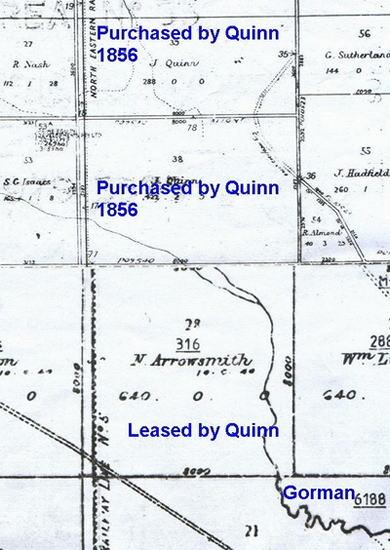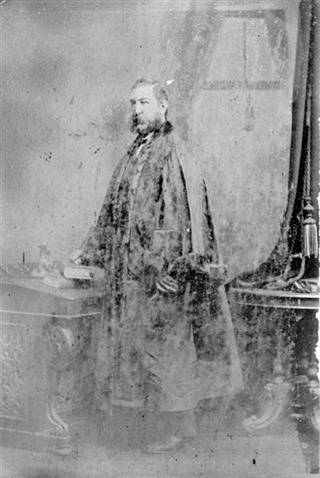|
The Politics of Ned
What links did Ned Kelly and his associates have with the
republican and federation movements in nineteenth-century
Australia?
Bill Denheld,
www.ironicon.com.au
Though I am not a
historian, I am very keen to find answers to questions about
puzzling aspects of the Ned Kelly story. It would appear
that the great volume of Ned Kelly books and articles, now
numbering more than 800, is owed to meticulous
record-keeping and reports of the circumstances and the case
against Kelly. It is therefore important to know which are
the primary and the secondary sources. I created a website,
ironicon.com.au or Ned Kelly! From Iron Outlaw to
Iron Icon, to share the research, knowledge and findings
I have collected which seem to contradict the accepted
‘Kelly history.’ While on the whole the Kelly drama has been
covered well, there does appear to be reluctance on the part
of many historians to delve into the politics of
Ned.
The following
statement, which appears on my website, explains my
approach:
This website does not glorify
bushrangers, criminals or denigrate officers of the law, it
simply presents the facts as reported at the time. It is not
possible to present theories without an element of
‘conjecture,’ for accepted history may one day be found to
be ‘not quite right.’ It is therefore the duty of all
historians to ask questions, and hopefully sometimes find
answers. This work is purely a quest to find truth and
balance and share that knowledge. Mistakes may be made along
the way for you to pick up on, so please feel free to add to
the story by contacting the author.
The Kelly story began when James and
Mary Quinn and their family of nine arrived in Melbourne in
July 1841. They were amongst the 344 bounty immigrants on
the ship England. Bounty immigrants had their passage
paid for by the new colony, which needed people to do manual
labour to open up the ‘untouched land.’ On board were 119
souls from England, twenty-two from Scotland and 203 from
Ireland. Protestants comprised 240 of the passengers while
Roman Catholics accounted for 104.[i]
By 1847 the Quinn family had
established itself at Wallan East, about 48 kilometres north
of Melbourne. The property title was held by ‘Arrowsmith,’
who leased it to ‘Cameron,’ who in turn sub-leased it to
‘Quinn.’ The property contained a large house and dairy
facilities. It was in the district that a released convict
John (Red) Kelly met James Quinn and his family; John
married daughter Ellen in 1850. To help the new couple get
started, Quinn allowed John and Ellen to build a small house
on a northern corner of his square-mile dairy farm.

Quinn’s eastern and southern boundaries adjoined the
property of Patrick and Mary Gorman, who had established
themselves in Wallan East some years earlier. Records show
the Gormans came out on the ship William Metcalf.
[ii]
(As an aside, the William Metcalfe was captained by
Captain Browne, whose son Thomas Alexander Browne, aka Rolf
Boldrewood, wrote the book Robbery Under Arms.)
Patrick and Mary Gorman had eight sons and two daughters.
The Gorman, Quinn and Kelly children all went to the
Catholic school in Beveridge. Having spoken with a
descendant of Patrick Gorman, David Gorman of Berrigan, I
can confirm that Mary Gorman was present as a midwife at Ned
Kelly’s birth. At around 1869, when most of the children had
grown up, the Gormans left the district. Emanuel James (E.J.)
Gorman set himself up at Berrigan, NSW, where land was more
affordable, and became a founding member of the Berrigan branch
of the Federation League; he convened the first two meetings
of the League, first in Berrigan and later in Corowa.
We read that Ned Kelly was born within one month of the
Eureka Stockade of December 1854, a dreadful event that set
in motion a visceral dislike for the British. I propose that
out of this resentment grew a movement represented by the
Victorian Natives’ Association (VNA), which later became the
Australian Natives’ Association (ANA). The ANA was a
co-operative that offered its members health insurance,
medical benefits and a political voice championing
federation.
Twenty years later, in the 1870s, with no shortage of social
inequities on display, Ned Kelly showed a determination to
draw a line in the sand against those social injustices
dished out to his class. One example of this was an incident
in which an old mate of Kelly’s, Alexander Fitzpatrick (now
a police officer), came calling for something Dan Kelly had
supposedly done. Kelly and Fitzpatrick had had illicit horse
dealings in the past, and it is thought that this may have
given Fitzpatrick reason to hound the Kellys whenever he
could. An altercation erupted and the constable was hit on
the head with a stove shovel by Ned’s mother Ellen. Someone
is alleged to have produced a revolver and Fitzpatrick was
wounded in the wrist and sent packing on his horse. Soon the
police were back to arrest Ned and Dan for attempted murder;
by this time they had fled into hiding. The police instead
arrested Ellen Kelly, with babe in arms, and placed an
arrest warrant on her two boys with rewards of 100 pounds
each (a huge sum for someone who was only ‘wanted’). Ellen
served three years, during which time the Kelly Gang
evolved.
It was not until six months later, with Ned still in hiding
in the ranges, that a police party dressed as prospectors
closed in on the Kelly camp after a tip-off from locals. The
Kellys, however, were aware of the police camped very close
to their hideout and a decision was made by Ned to seize the
initiative after they had noticed the police had two
pack-horses ready with undertaker body-straps. A shoot-out
resulted, with three of the four police shot dead. We could
ask, ‘did the Kellys kill the police in self defence’? Many
believed so, but a fair trial would never be afforded to
Kelly and he was later hanged.
The killings of the three police at
Stringybark Creek became the biggest story in the media and
reporters milked the panic until it became hysteria. When
Ned was caught twenty months later it should be noted that
Alfred Deakin was the legal journalist at the Age;
later he was attorney-general in the first Australian
parliament and, later still, prime minister. Deakin was
meant to report on Kelly’s trial on a daily basis in order
to guarantee Kelly got a fair go. This was an arrangement
sought by Ned’s lawyer, David Gaunson, who worked hard to
defend Ned’s murder charge on the grounds of self-defence.[iii]
Instead, the Age and the Argus, which tended
to reflect the Protestant viewpoint, continued the negative
reporting of Ned for months, perhaps partly because they
distrusted Samuel Winter, an Irish-Catholic and founding
member of the ANA, who owned the popular Herald.

Samuel Winter in his Mayoral robe- circa 1871,
Image,
courtesy Herald Sun
I have not yet read a history book
that draws a connection between Ned Kelly and those that led
the charge for a fairer society, such as his Beveridge
schoolmates and neighbors the Gormans. A booklet on the
history of the ANA, One Nation with One Destiny,
tells of the ANA’s influential push towards federation, but
as to the ANA’s founders, it only says these comprised ‘a
small group of men’ without any mention to those who
happened to be very close to the Kellys – the Gormans and
the Quinns.[iv]
There is, however, no shortage of accolades for Edmund
Barton, who became our first prime minister, and Alfred
Deakin, who were both members of the ANA. E.J. Gorman and
Samuel Winter, founders of the VNA and ANA respectively, do
not rate a mention; as the diagram shows both men had strong
connections with the Kellys.
Some will say Ned Kelly’s connections to the ‘drivers of
change’ in nineteenth-century Australia is of little or no
consequence, yet if we want to be fair about this factual
historical connection, we need to ask why these names have
been absent from our history books. David Gorman’s
grandfather, Joseph Winter, owned and ran the Advocate,
a Catholic-orientated Melbourne newspaper expressing
Irish-Australian views, while Joseph’s brother Samuel ran
the Herald – the brothers were a formidable political
force, particularly as Samuel was a key player in the ANA,
which spear-headed the move towards federation.
Ned Kelly and Joe Byrne are said to
have made plans for a ‘Republic of North-eastern Victoria.’
A printed page of block text regarding the plan is known to
have existed, and journalist Leonard Radic (whom Ian Jones,
noted Kelly historian, describes as ‘a highly reputable
witness’) says he saw this document displayed in a British
Library Museum in 1962.[v]
Unfortunately it has become lost since then; if ever found
it might raise Ned Kelly’s status to that of republican
forefather.
Putting all the evidence together it is highly likely that
Ned Kelly would have been pleased that his family friends –
the Gormans and Winters – helped to bring about a parliament
by the people, for the people, in Australia in 1901. The
extent to which these activists were influenced by the
rebellious actions and beliefs of Kelly himself is yet
another fascinating question.
________________________________________________________________________________________________________
[i]
Records from the England confirm the arrival
of James Quinn. Go to
http://vic1847.comlu.com/41/eg41.html.
[ii]
Records from the William Metcalfe can be seen
at http://vic1847.comlu.com/ship39.html#wil.
[iii]
Alex C. Castles and Jennifer Castles, Ned Kelly’s
Last Days: Setting the Record Straight on the Death
of the Outlaw (NSW: Allen & Unwin, 2005).
[iv]
Judy Johnson, One Nation with One Destiny: The
Role of the Australian Natives’ Association in the
Federation of Australia (Melbourne: ANA, 1984).
[v]
Ian
Jones, Ned Kelly: A Short Life (2003), 200–
1.
|
![]()
![]()
![]()
![]()
![]()